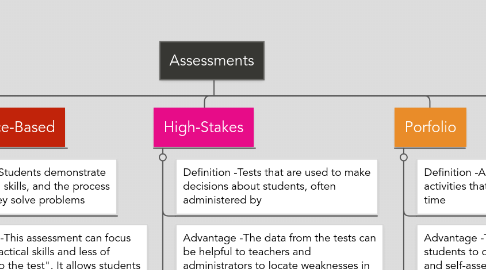Assessments
by Molly Kraybill


1. Summative
1.1. Definition -Assessment used to evaluate student learning at the end of a project, unit, or school year
1.2. Advantage -Can provide motivation for students to participate and study. They often can provide good insight to the teacher about instruction and how to alter future lessons for more effective learning
1.3. Disadvantage -Students can have anxiety about summative assessments. They are not always an accurate reflection of the learning process.
1.4. Learning -This is an assessment Of Learning, because it tells you what students have learned at the end of the unit
1.5. Example -An end of unit essay based on a rubric about how a painting reflects a certain culture and time period
2. High-Stakes
2.1. Definition -Tests that are used to make decisions about students, often administered by
2.2. Advantage -The data from the tests can be helpful to teachers and administrators to locate weaknesses in the curriculum. Teachers can use the data to look for progress in certain areas.
2.3. Disadvantage -These assessments create high anxiety for both students and teachers. Essential subjects like history and the arts can be pushed aside to make more time for testing. The multiple choice questions don't assess for multiple type of learning, and can be challenging for ELL and SPED students.
2.4. Learning -High-stakes testing is often used as assessment Of Learning, in that the tests measure end of unit understanding
2.5. Example - PARCC testing. There are no state wide high-stakes assessments in the art room.
3. Authentic
3.1. Definition -Assessment where students are asked to perform real-world tasks that demonstrate understanding of knowledge and skills
3.2. Advantage -These assessments ensure that students are learning real life skills. Teachers will first design the curriculum around the assessment.
3.3. Disadvantage -The subjective nature of the grading could lead to bias. It also could be challenging to fit this kind of learning into most traditional curriculum.
3.4. Learning -This is an assessment Of Learning, because it demonstrates knowledge of a certain skill or content
3.5. Example -A video that demonstrates mass-media advertising techniques
4. Performance-Based
4.1. Definition -Students demonstrate knowledge, skills, and the process in which they solve problems
4.2. Advantage -This assessment can focus more on practical skills and less of "teaching to the test". It allows students for more flexibility in showing their thinking.
4.3. Disadvantage -Because there are often no right or wrong answers, it can be tricky to grade using this assessment without being subjective
4.4. Learning -This could be used for an end of unit Of Learning assessment, but also could be used to assess For Learning as a sort of a mid-unit formative assessment.
4.5. Example-A paper worksheet that demonstrates shading and cross-hatching technique with pencil
5. Porfolio
5.1. Definition -A collection of student activities that show growth over time
5.2. Advantage -The portfolio allows students to continuously reflect and self-assess. Students have ownership as they get to decide what goes in and how to make improvements.
5.3. Disadvantage -The process can be labor intensive to give extensive and constructive feedback to each student.
5.4. Learning -This is an assessment Of Learning, because students and teachers can see student progress
5.5. Example-An art portfolio that shows growth in a certain artistic medium, such as drawing or painting
6. Peer Assesment
6.1. Definition -Assessment that is done by another student, often based on a rubric of prompt
6.2. Advantage - Encourages collaboration and community in the classroom. It is helpful to have someone from an outside perspective give feedback.
6.3. Disadvantage -Students could feel uncomfortable giving negative feedback to peers. It may be hard to implement with younger children.
6.4. Learning -Most often used to assess Of Learning during an end of unit assessment.
6.5. Example - A peer-critique based on an art rubric
6.6. References
6.6.1. Stiggins, R. (n.d.). Assessment For Learning defined. Retrieved June 18, 2016, from http://ati.pearson.com/downloads/afldefined.pdf
6.6.2. Assessment. (n.d.). Retrieved June 18, 2016, from http://learningtoassess.blogspot.com/2010/12/advantages-and-disadvantages-of-self.html

